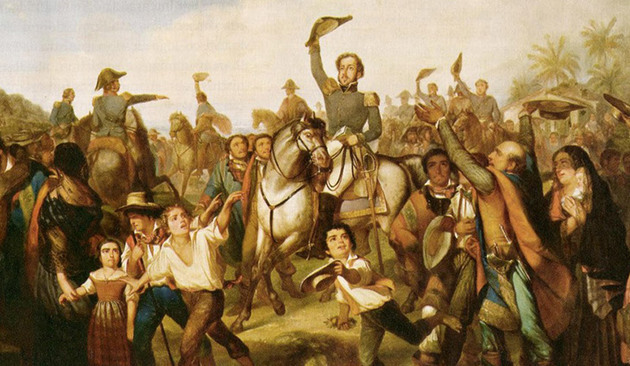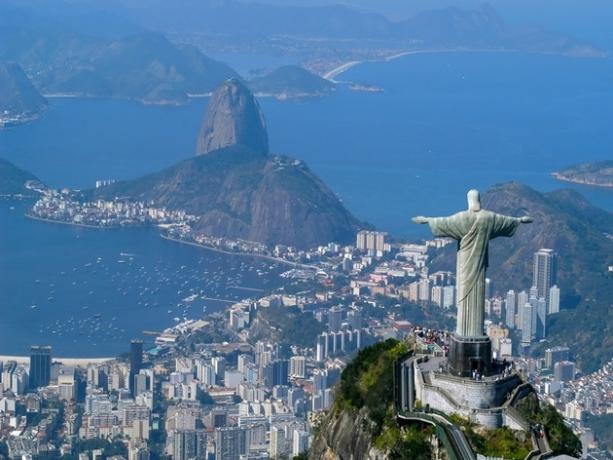O Brazil, officially the Federative Republic of Brazil, is a country located in South America.
It is considered the 5th country in territorial extension, owner of one of the greatest biodiversity on the planet and whose economy is the eighth in the world (2017).
Data from Brazil
- Official name: Federative Republic of Brazil
- Form and Government system: Presidential republic
- capital: Brasilia
- territorial division: 26 states and 1 Federal District
- Area: 8,516,000 km2
- Population: 209.3 million (2017)
- GDP: 2.056 trillion dollars (2017)
- Coin: Real
- Official language: Portuguese and Libras
- Head of Government and State: Jair Bolsonaro (since January 1, 2019)
Important dates
- Independence: September 7, 1822 (197 years)
- Proclamation of the Republic: November 15, 1889 (130 years old)
Location of Brazil

Brazil is located in South America and borders all countries on the continent except Chile and Ecuador. It is the largest country on the continent and occupies 47% of the territory.
Located in the southern hemisphere, the country is crossed by the Equator and the Tropic of Capricorn.
Brazil is bathed by the Atlantic Ocean and its maritime border stretches 22 km (12 nautical miles) from the coast.
Learn more about Brazilian territory.
Brazil's flag

The current Brazilian flag was made official on November 19, 1889 by the republican regime. It was inspired by the imperial flag and kept its main colors as green and yellow.
The imperial coat of arms was replaced by a blue disk, representing the starry sky and a banner with the words "Order and Progress".
The national pavilion was created by Raimundo Teixeira Mendes, with the contribution of philosopher Miguel Lemos, painter Décio Villares and astronomer Manuel Pereira Reis.
Brazil states
The Brazilian territory is divided into 26 states and 1 Federal District.

Check out the names of the states, acronyms and capitals below:
- Acre (AC) - Rio Branco
- Alagoas (AL) - Maceio
- Amapá (AP) - Macapá
- Amazonas (AM) - Manaus
- Bahia (BA) - Salvador
- Ceará (CE) - Fortaleza
- Federal District (DF) - Brasilia
- Espírito Santo (ES) - Vitória
- Goiás (GO) - Goiânia
- Maranhão (MA) - São Luís
- Mato Grosso (MT) - Cuiabá
- Mato Grosso do Sul (MS) - Campo Grande
- Minas Gerais (MG) - Belo Horizonte
- Pará (PA) - Belém
- Paraíba (PB) - João Pessoa
- Paraná (PR) - Curitiba
- Pernambuco (PE) - Recife
- Piauí (PI) - Teresina
- Rio de Janeiro (RJ) - Rio de Janeiro
- Rio Grande do Norte (RN) - Natal
- Rio Grande do Sul (RS) - Porto Alegre
- Rondônia (RO) - Porto Velho
- Roraima (RR) - Boa Vista
- Santa Catarina (SC) - Florianópolis
- São Paulo (SP) - São Paulo
- Sergipe (SE) - Aracaju
- Tocantins (TO) - Palmas
Government of Brazil
Brazil has a presidential and bicameral system of government.
Executive power
O Executive power it is exercised by the President of the Republic who is the Head of State and Head of Government. The representative is chosen through direct elections for a four-year term.
In the states, executive power is exercised by the governor and in the city, by the mayor. Both are elected through direct elections, with a secret ballot and for a four-year term.
Legislative power
O Legislative power Brazil, at the federal level, is formed by two chambers: Deputies and Senators.
In states and cities there is only one legislative chamber. At the state level there is the Chamber of Deputies, where state deputies legislate and, in the municipalities, the Chamber of Councilors.
Judicial power
O Judicial power it is exercised at the federal and state level by judges, who work both in the common and in the special courts. This comprises the Labor Court, the Electoral Court and the Military Court.
Unlike members of the Executive and Legislative branches, members of the Judiciary are not elected by the population to the position.
To be a judge, the candidate must have a degree in Law and have passed a public examination. After two years in the magistracy, the position becomes for life.
Economy of Brazil
Brazil's economy is extremely diversified, covering the primary, secondary and tertiary sectors.
Brazil is a major exporter of agricultural products such as citrus fruits, soy and meat. It also stands out in the area of extractivism mineral and vegetable.
The industrial activity is formed by the petrochemical, aeronautics and fertilizer sector, as well as an expressive footwear and clothing industry.
Learn more about the topic:
- Economy of Brazil
- Agriculture in Brazil
- Industrialization in Brazil
history of Brazil
The history of Brazil is divided into three major phases: colonial, empire and republic.
Brazil Colony
It is considered that the period of colonial Brazil's history began on April 22, 1500 with the arrival of Pedro Álvares Cabral's squadron and ended with the elevation of Brazil to the category of United Kingdom.
Some historians, however, claim that this period only ends with independence on September 7, 1822.
For three hundred years, the indigenous people who lived here underwent a radical change in their way of life with the arrival and installation of the Portuguese.
Then the settlers brought the Africans to be enslaved and to work in the sugar cane plantations. This activity was developed mainly in northeastern Brazil, but there were crops installed in other parts of the territory.
Also at this time the activity of the Girl Guides can be observed, groups of people who organized and they went on expeditions through the interior in search of Indians to enslave them, of gold and stones precious.
Gold in Minas Gerais
The discovery of gold in Minas Gerais meant the shift of economic activity to the Southeast.
The capital was transferred from Salvador to Rio de Janeiro, in order to improve control of the precious metal's output to Portugal.
Likewise, there are some uprisings against the Portuguese authority. In 1789 the conspiracy known as Mining Inconfidence and, in 1798, the Bahia Conjuration.
Brazil Empire

The stage of Brazil's imperial history begins with the proclamation of independence by Dom Pedro, who will become the country's first emperor.
However, without getting support for his political project and fearful of losing the Portuguese choir, Dom Pedro I he ends up abdicating the throne to his son.
Then follows the Governing Period, where the government was administered by regents. This stage is characterized by political struggles and revolts in several Brazilian provinces.
second reign
The Second Reign begins when Dom Pedro II has his early adulthood and assumes the throne of the empire of Brazil.
There follows a period of relative domestic political calm and economic prosperity due to the profits brought in by growing coffee.
The big discussion about the abolition of slavery in Brazil which will be the cause of the monarchy's downfall.
Brazil Republic
The republican regime is installed in Brazil through a coup orchestrated by the army and the coffee elite.
At first, the republic is not well accepted by the population, as the numerous uprisings such as the Straw War, a Contested War or even the Vaccine Revolt.
The republican period, in force until today, is marked by the rupture of the democratic order in occasions such as the It was Vargas and the Military dictatorship.
Brazil climates
Brazil is located between the Equator and the Tropic of Capricorn. In this way, it is located in the tropical zone where the climate is hot and humid.
The Brazilian climate is divided into six major types:
| Climate | Region |
|---|---|
| Subtropical | South |
| Tropical | Southeast, Center. West and Northeast |
| Tropical Atlantic (or Coastal) | All Atlantic coast except the southern states of Brazil |
| Altitude Tropical | Sierras in the Southeast and Midwest |
| semiarid | northeastern hinterland |
| Equatorial | North and Midwest |
Biomes of Brazil
According to the IBGE (Brazilian Institute of Geography and Statistics), Brazil has six major biomes.
| Biome | Region |
|---|---|
| Amazon | North and the states of Mato Grosso and Maranhão |
| wetland | Midwest |
| Atlantic forest | From the state of Rio Grande do Norte to Rio Grande do Sul |
| Caatinga | North East |
| thick | Northeast, Midwest and Southeast |
| Pampas | South |
Learn more about the topic:
- Vegetation of Brazil
- geography of Brazil
- Brazilian relief
Brazilian culture
The culture of Brazil is the result of the mixture of Portuguese, indigenous, African, Italian, Japanese, German, etc. traditions. Added to this are the religious festivals typical of Catholicism and African celebrations in honor of the orixás.
There are well-marked regional characteristics reflected in celebrations such as the Festa da Uva, in Rio Grande do Sul and the Marujada, in Pará. However, we can find throughout the country a taste for music, the use of beans in the preparation of various dishes and rhythms such as samba and forró.
Likewise, the spread of several Amazonian indigenous legends contributed to the elaboration of a common culture among all Brazilians.
Brazil Tourism

Brazil has a huge potential for tourism due to its natural resources and cultural offer.
The country receives around 6 million foreign visitors a year and has significant internal tourism around culture, religious and cultural festivals such as carnival and June festivals.
The most visited cities in Brazil are Rio de Janeiro, Florianópolis, Foz do Iguaçu, São Paulo, Salvador, Gramado, Natal, Porto Seguro, Caldas Novas, Fortaleza.
Curiosities about Brazil
- biggest river: Amazon River (6992.06 km)
- Highest point: Pico da Neblina/AM with 2,993.8 meters
- greater state: Amazonas (1 559 146.876 km2)
- minor state: Sergipe (21,910 km2)
- The most popular city: Sao Paulo-SP
- oldest city: São Vicente/SP
See too: The History of Brazil

